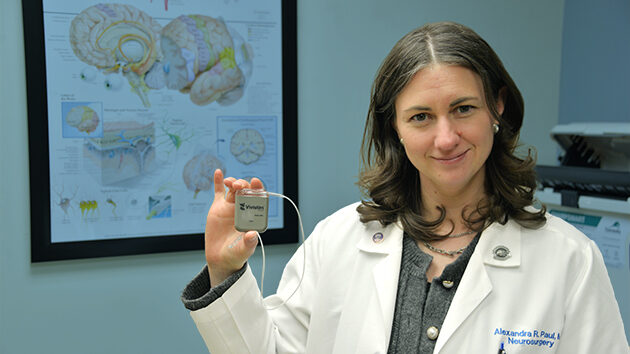Breakthrough Vivistim Technology Helps Restore Upper Limb Mobility for Stroke Survivors

In a first in upstate New York, Albany Medical Center has implanted a device intended to improve arm and hand function in patients who have experienced a debilitating stroke.
MicroTransponder’s Vivistim Paired VNS System is an FDA-approved breakthrough technology that uses vagus nerve stimulation during rehabilitation. Studies in chronic stroke survivors have demonstrated that upper limb rehabilitation used in conjunction with the Vivistim System resulted in two to three times greater arm and hand function than therapy alone.
The small palm-sized device is placed in the patient’s upper left chest. During rehabilitation, a therapist uses a wireless transmitter that communicates with software to signal the Vivistim device to deliver a gentle pulse to the vagus nerve—part of the nervous system where bodily functions are controlled—while the patient performs a specific task, such as opening a door, preparing food, or getting dressed.
Alexandra Paul, MD, endovascular neurosurgeon at Albany Medical Center, was the first to use the technology in an outpatient procedure performed on Jenna Shersky, 46, of Delmar, in September. Previously an avid skier and hiker, Shersky has had limited use of her dominant (left) side since experiencing an ischemic stroke in 2022.
“Like many ischemic stroke survivors, Jenna’s rehabilitation therapy had reached a plateau, but she has noticed progress since using the Vivistim therapy,” said Dr. Paul.
Frances Williams, occupational therapist at Albany Medical Center’s Outpatient Therapy Office, is specially trained to help patients work with the device. The pairing of rehabilitation exercise with vagus nerve stimulation helps strengthen neural connections to improve upper limb function.
“Vivistim is the most promising technology for stroke survivors with chronic upper limb impairment that has emerged over the course of my entire career in occupational therapy,” she said. “Since finishing her first round of vagus nerve stimulation-paired occupational therapy, we’ve already observed that Jenna has been able to use her weaker arm for more daily tasks. The research behind this and Jenna's progress has been so encouraging and inspiring to see, that I hope as word gets out this will become part of the standard of care for all ischemic stroke survivors with moderate to severe limb impairment.”
“We’re grateful to have the resources and support from our rehab partners to offer this revolutionary treatment to stroke survivors,” said Dr. Paul. “As we continue to leverage advanced technology for the rapid treatment of stroke patients, it is even more important that we offer patients treatments that will continue to help them in their recovery, enabling them to regain their independence and improve their quality of life.”
Shersky hopes her progress will inspire others. “I’m slowly beginning to see some progress in activities like opening doors and pushing something across the counter and I believe I’ll continue to get good results,” she said. “I’m fortunate to be the first patient in the region to receive this therapy and I hope more patients will learn about the technology so they can benefit as well.”
Albany Medical Center is the region’s only Comprehensive Stroke Center. The hospital’s stroke team is available 24/7 to provide patients with leading-edge treatments to improve their chances of a successful recovery and provides consultation and works closely with other hospitals in the System, and throughout upstate New York, western Massachusetts, and Vermont to facilitate rapid transfer of patients for evaluation and treatment of stroke.